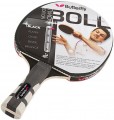Control
Table tennis rackets have 3 main practical characteristics: speed, spin and control. The general class of the product, the style of play (see above), available techniques, requirements for player skills, etc. depend on their values and ratio. One of the most popular designation options is on a hundred-point scale; This scale is also used in our catalogue.
Control describes the overall handling of a racket. Roughly speaking, this is a parameter of how easily it can be used to give the tennis ball exactly the speed, direction of flight and rotation that the athlete wants to provide. High values on the control scale will be comfortable regardless of the level of the player and the style of play; however, increasing the speed/rotation hurts control, as a “faster” or “spinning” racket is usually more demanding on the accuracy of movements. Therefore, many models for professionals and experienced amateurs, usually, are distinguished by a low degree of controllability, and “beginner” rackets, on the contrary, have high control parameters and low speed/spin.
Sponge thickness
The sponge is the bottom layer of the coating, located under the outer coating (rubber is most often used for such a coating). The thickness of the sponge determines the characteristics of the impulse that the racket transmits to the ball, and, accordingly, the characteristics of the flight of the ball after the impact; in other words, this parameter affects all three practical characteristics of the racket - speed, rotation, control. Accordingly, models for different playing styles (see above) also differ in sponge thickness.
So, a small thickness - up to 1.5 mm - is typical for protective style products, which are distinguished by low speed and good control. All-purpose rackets use sponges of the thickness of 1.5 – 1.8 mm, which provides a balance between speed and control. And thick sponges - from 2 mm - are installed in rackets for an attacking game, and the greater the thickness, the higher the speed and rotation, and the worse the control.
Adjustable gravity centre
The ability to change the overall balance of the racket by moving the balance point (centre of gravity) closer to or further from the end of the handle. In this way, you can adjust the product to your own preferences and playing style, and even quickly reconfigure the racket depending on the situation — many models allow you to change settings within a couple of minutes. Adjustment, usually, is carried out by rearranging the ballast placed in the handle. There is also
an adjustment of the gravity centre of high-class rackets
4 * and 5 * (see "Class").

